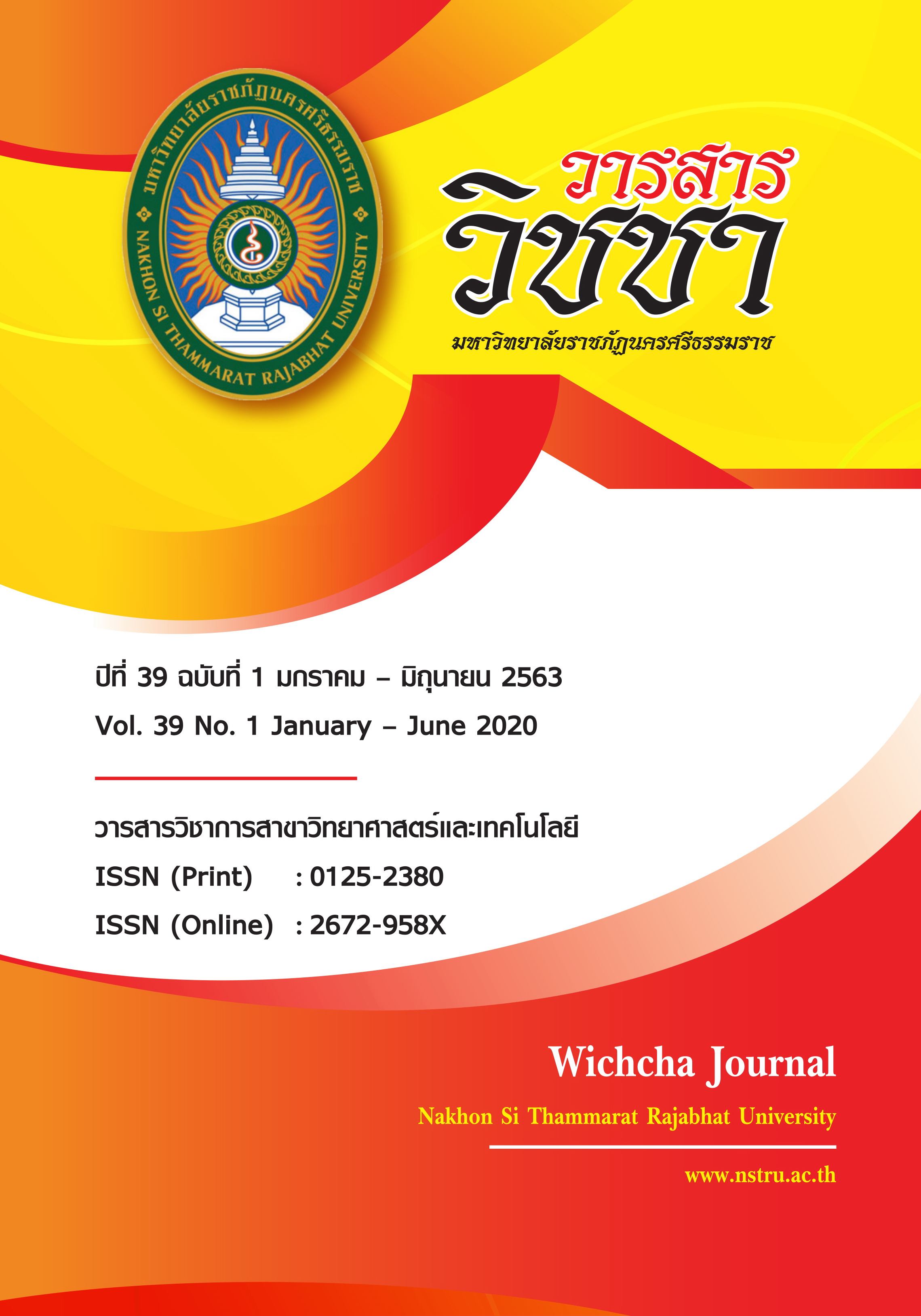Diversity of Bio-oil Freshwater Microalgae in Satuek District, Buri Ram Province ความหลากหลายของสาหร่ายน้ำจืดขนาดเล็กผลิตน้ำมันในอำเภอสตึก จังหวัดบุรีรัมย์
Main Article Content
Abstract
Nowadays, there are increasing energy consumption, especially energy from oil. According to the search of renewable energy sources, there are found that freshwater microalgae have the potential to produce oil more cost-effective than many oil plants do. The aims of this research were to study the diversity of freshwater microalgae, examine freshwater microalgae for bio-oil production by Nile Red Staining technique and compare them with the results of previous research. The collection of microalgae used a 10 micrometer plankton net from water sources in Satuek district, Buri Ram province. The results found that diversity of microalgae could be classified into 5 divisions, 22 families, 47 genus, 71 species. There were 15 species of microalgae that can produce bio-oil, most of them were Chlorophyta division. The tests of bio-oil production among the 3 microalgae; namely, Botryococcus braunii, Scenedesmus acuminatus and Chlorella sp. found that B. braunii produced the highest amount of oil because almost full of its cells had yellow glow. This microalgae were found at the stations of number 3, 7, 8 and 12; which were Ban Nong Nam Khun, Ron Thong Subdistrict, Ban Sakor Sai and Ban Talat, Nikom Subdistrict, and Ban Sakae, Sakae Subdistrict, respectively. The most diverse species of microalgae for bio-oil production were found at the station of number 12. The data of microalgae for bio-oil production from this research are new data to be used as an alternative energy source.
Article Details
เนื้อหาและข้อมูลในบทความที่ลงตีพิมพ์ในวารสารวิชชา มหาวิทยาลัยราชภัฏนครศรีธรรมราช ถือเป็นข้อคิดเห็นและความรับผิดชอบของผู้เขียนบทความโดยตรง ซึ่งกองบรรณาธิการวารสารไม่จำเป็นต้องเห็นด้วยหรือร่วมรับผิดชอบใด ๆ
บทความ ข้อมูล เนื้อหา รูปภาพ ฯลฯ ที่ได้รับการตีพิมพ์ในวารสารวิชชา มหาวิทยาลัยราชภัฏนครศรีธรรมราช ถือเป็นลิขสิทธ์ของวารสารวิชชา มหาวิทยาลัยราชภัฏนครศรีธรรมราช หากบุคคลหรือหน่วยงานใดต้องการนำข้อมูลทั้งหมดหรือส่วนหนึ่งส่วนใดไปเผยแพร่ต่อหรือเพื่อการกระทำการใด ๆ จะต้องได้รับอนุญาตเป็นลายลักษณ์อักษรจากวารสารวิชชา มหาวิทยาลัยราชภัฏนครศรีธรรมราชก่อนเท่านั้น
The content and information in the article published in Wichcha journal Nakhon Si Thammarat Rajabhat University, It is the opinion and responsibility of the author of the article. The editorial journals do not need to agree. Or share any responsibility.
References
ไพริน สุดทัง สรัญญา วัชโรทัย ศรีสม สุวรรณวงศ์ และณัฏฐา เสนีวาส. (2553). ความหลากหลายของสาหร่ายแนวดิ่งในบึงบอระเพ็ดจังหวัดนครสวรรค์. พฤกษศาสตร์ไทย, 2 (พิเศษ), 21-31.
ภาณินี จรุงกีรติวิมล จารุวรรณ ชลสงคราม วีระสิทธิ์ สรรพมงคลไชย สุมัลลิกา โมลากุล และประมุข ภระกูลสุขสถิต. (2559). การเปรียบเทียบการเจริญและการผลิตลิพิดระหว่าง Ankistrodesmus sp. IFRPD No. 1061 และ Chlorella sp. IFRPD No. 1092 ในบ่อเปิดแบบรางคู่. ใน การประชุมทางวิชาการของมหาวิทยาลัยเกษตรศาสตร์ ครั้งที่ 54 (หน้า 1004-1011). กรุงเทพฯ: มหาวิทยาลัยเกษตรศาสตร์.
ยุวดี พีรพรพิศาล. (2546). สาหร่ายวิทยา (Phycology). เชียงใหม่: ภาควิชาชีววิทยา คณะวิทยาศาสตร์ มหาวิทยาลัยเชียงใหม่.
ยุวดี พีรพรพิศาล. (2556). สาหร่ายน้ำจืดในประเทศไทย. (พิมพ์ครั้งที่ 2). เชียงใหม่: โชตนาพริ้นท์จำกัด.
ลัดดา วงศ์รัตน์. (2540). คู่มือการเลี้ยงแพลงก์ตอน. กรุงเทพฯ: มหาวิทยาลัยเกษตรศาสตร์.
ลัดดา วงศ์รัตน์. (2542). แพลงก์ตอนพืช (Phytoplankton). กรุงเทพฯ: มหาวิทยาลัยเกษตรศาสตร์.
สุนีรัตน์ เรืองสมบูรณ์ ศักดิ์ชัย ชูโชติ ปวีณา ทวีกิจการ และมณฑล แก่นมณี. (2555). การคัดเลือกสายพันธุ์และการเพาะเลี้ยงสาหร่ายที่มีไขมันสูงแบบมหมวลเพื่อความเป็นไปได้ในการผลิตเชื้อเพลิงชีวภาพ. ได้รับทุนสนับสนุนงานวิจัยจากเงินงบประมาณแผ่นดิน ประจำปีงบประมาณ 2555. สถาบันเทคโนโลยีพระจอมเกล้าเจ้าคุณทหารลาดกระบัง.
อรพรรณ พรหมธนพันธ์ และรัฐภูมิ พรหมณะ. (2556). น้ำมันชีวภาพที่สกัดจากไซยาโนแบคทีเรียและสาหร่ายสีเขียวบางชนิดที่พบในจังหวัดพะเยาและจังหวัดน่าน. นเรศวรพะเยา, 6(2), 96-99.
Abdo, S.M., Ahmed, E., El-Enin, S.A., El Din, R.S., Diwani, G.E. and Ali, G. (2013). Growth rate and fatty acids profile of 19 microalgal strains isolated from river Nile for biodiesel production. Journal of Algal Biomass Utilization, 4(4), 51-59.
Abdo, S.M., Ahmed, E., El-Enin, S.A., El-Din, R.S., Diwani, G.E. and Ali, G. (2014). Qualitative and quantitative determination of lipid content in microalgae for biofuel production. Journal of Algal Biomass Utilization, 5(3), 223-228.
Bold, H.C. and Wynne, M.J. (1985). Introduction to the algae. (2nd ed). New Jersey: Prentice-Hall.
Boni, J., Aida, S. and Leila, K. (2018). Lipid extraction method from microalgae Botryococcus braunii as raw material to make biodiesel with soxhlet extraction. Journal of Physics, 1095(1), 012004.
Chen, W., Zhang, C., Song, L., Sommerfeld, M. and Hu, Q. (2009). A high throughput Nile red method for quantitative measurement of neutral lipids in microalgae. Journal of Microbiological Methods, 2009(77), 41-47.
Chisti, Y. (2007). Biodiesel from microalgae. Biotechnology Advances, 25(3), 294-306.
Chtourou, H., Dahmen, I., Karray, F., Sayadi, S. and Dhouib, A. (2015). Biodiesel production of Amphora sp. and Navicula sp. by different cell disruption and lipid extraction methods. Journal of Biobased Materials and Bioenergy, 9(6), 588-595.
Dehaghani, A.H.S. and Pirouzfar, V. (2018). Investigation on the effect of microalgae Chlorella sp. and Spirulina on biodiesel production. Petroleum Chemistry, 58(8), 702-708.
Diaz, G., Melis, M., Batetta, B., Angius, F. and Falchi, A.M. (2008). Hydrophobic characterization of intracellular lipids in situ by Nile red red/yellow emission ratio. Micron, 39(7), 819-824.
Dilia, P. and Leila, K. (2018). Fatty acids from microalgae Botryococcus braunii for raw material of biodiesel. Journal of Physics, 1095(1), 012010.
Gani, P., Sunar, N.M., Matias-Peralta, H.M., Latiff, A.A.A., Parjo, U.K., Embong, Z., Khalid, A. and Tajudin, S.A.A. (2016). The potential of biodiesel production from Botryococcus sp. biomass after phycoremediation of domestic and industrial wastewater. Materials Science and Engineering, 160(1), 1-9.
Graham, L.E., Graham, J.M. and Wilcox, L.W. (2009). Algae (2nd ed). California: Benjamin Cummings.
Gusbeth, C.A., Eing, C., Göttel, M., Straßner, R. and Frey, W. (2016). Fluorescence diagnostics for lipid status monitoring of microalgae during cultivation. Journal of Renewable Energy & Biofuels, 2016(1), 1-12.
Melanie, S. and Fithriani, D. (2015). Determination of oil extraction rate from Spirulina sp. and Chlorella sp. by using cell disruption technique. Journal of Widyariset, 1(1), 61-70.
Nascimento, A.I., Marques, S.S.I., Cabanelas, I.T.D., Carvalho, G.C., Nascimento, M.A., Souza, C.O., Druzian, J.I., Hussain, J. and Liao, W. (2014). Microalgae versus land crops as feedstock for biodiesel:productivity, quality, and standard compliance. BioEnergy Research, 7(3), 1002-1003.
Patel, V.K., Sundaram, S., Patel, A.K. and Kalra, A. (2017). Characterization of seven species of cyanobacteria for high-quality biomass production. Arabian Journal for Science and Engineering, 43(1), 109-121.
Prasertsin, T. and Peerapornpisal, Y. (2018). Distribution and isolation of microalgae for lipid production in selected freshwater reservoirs of northern Thailand. Biodiversitas, 19(1), 343-350.
Rattanapoltee, P. and Kaewkannetra, P. (2013). Nile red, an alternative fluorescence method for quantification of neutral lipids in microalgae. Journal of Biotechnology and Bioengineering, 7(9), 889-893.
Unpaprom, Y., Tipnee, S. and Rameshprabu, R. (2015). Biodiesel from green alga Scenedesmus acuminatus. International Journal of Sustainable and Green Energy, 4(1-1), 1-6.
Xu, L., Brilman, D.W.F.W., Withag, J.A.M., Brem, G. and Kersten, S.R.A. (2011). Assessment of a dry and a wet route for the production of biofuels from microalgae: Energy balance analysis. Bioresource Technology, 102(8), 5113-5122.


